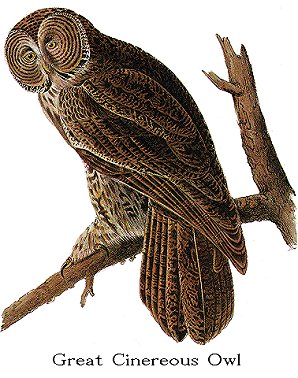
|
Family III. STRIGINAE. OWLS.
GENUS IV. SYRNIUM, Cuv. HOOTING-OWLS. |
Next >> |

Family |
GREAT CINEREOUS OWL. [Great Gray Owl.] |
| Genus | SYRNIUM CINEREUM, Linn.
[Strix nebulosa.] |
This fine Owl, which is the largest of the North American species, is nowhere common with us, although it ranges from the north-eastern coast of the
United States to the sources of the Columbia river. It has been procured near
Eastport in Maine, and at Marblehead in Massachusetts, where one of them was
taken alive, perched on a wood pile, early in the morning, in February, 1831. I
went to Salem for the purpose of seeing it, but it had died, and I could not
trace its remains. The gentleman, Mr. IVES, in whose keeping it had been for
several months, fed it on fish and small birds, of which it was very fond.
Besides shewing me various marks of attention, he gave me a drawing of it made
by his wife, which is still in my possession. It uttered at times a tremulous
cry not unlike that of the Little Screech Owl, Strix Asio, and shewed a great
antipathy to cats and dogs. In the winter of 1832, I saw one of these Owls
flying over the harbour of Boston, Massachusetts, amid several Gulls, all of
which continued teasing it until it disappeared. I have seen specimens procured
on the Rocky Mountains by Mr. TOWNSEND, and several brought to London by the
medical officer who accompanied Captain BACK in his late Arctic journey. Among
the individuals which I have examined I have found considerable differences as
to size and markings, which may be attributed to age and sex. My drawing was
token from a remarkably fine specimen in the collection of the Zoological
Society of London.
The comparatively small size of this bird's eyes renders it probable that
it punts by day, and the remarkable smallness of its feet and claws induces me
to think that it does not prey on large animals. Dr. RICHARDSON says that "it
is by no means a rare bird in the Fur Countries, being an inhabitant of all the
woody districts lying between Lake Superior and latitudes 67 degrees or 68
degrees, and between Hudson's Bay and the Pacific. It is common on the borders
of Great Bear Lake; and there, and in the higher parallels of latitude, it must
pursue its prey, during the summer months, by day-light. It keeps however
within the woods, and does not frequent the barren grounds, like the Snowy Owl,
nor is it so often met with in broad day-light as the Hawk Owl, but hunts
principally when the sun is low; indeed, it is only at such times, when the
recesses of the woods are deeply shadowed, that the American hare and the murine
animals, on which the Cinereous Owl chiefly preys, come forth to feed. On the
23d of May I discovered a nest of this Owl, built on the top of a lofty balsam
poplar, of sticks, and lined with feathers. It contained three young, which
were covered with a whitish down. We got them by felling the tree, which was
remarkably thick; and whilst this operation was going on, the two parent birds
flew in circles round the objects of their cares, keeping, however, so high in
the air as to be out of gunshot; they did not appear to be dazzled by the light.
The young ones were kept alive for two months, when they made their escape.
They had the habit, common also to other Owls, of throwing themselves back, and
making a loud snapping noise with their bills, when any one entered the room in
which they were kept."
GREAT GREY or CINEREOUS OWL, Strix cinerea, Nutt. Man.,
vol. i. p. 128.
CINEREOUS OWL, Strix cinerea, Swains. and Rich., F. Bor. Amer.,
vol, ii. p. 77.
GREAT CINEREOUS OWL, Strix cinerea, Aud. Orn. Biog., vol. iv. p. 364.
Upper parts greyish-brown, variegated with greyish-white in irregular
undulated markings; the feathers on the upper part of the head with two
transverse white spots on each web; the smaller wing-coverts of a darker brown,
and less mottled than the back; the outer scapulars with more white on their
outer webs; primaries blackish-brown toward the end, in the rest of their extent
marked with a few broad light-grey oblique bands, dotted and undulated with
darker; tail similarly barred; ruff-feathers white toward the end, dark brown in
the centre; disks on their inner sides grey, with black tips, in the rest of
their extent greyish-white, with six bars of blackish-brown very regularly
disposed in a concentric manner; lower parts greyish-brown, variegated with
greyish and yellowish-white; feet barred with the same.
Female, 30 1/2, 48 1/2.
| Next >> |